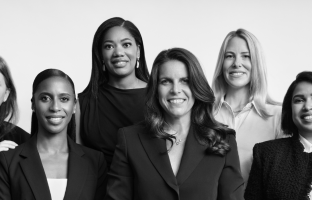In a snapshot of the PresenceLearning leadership team taken this spring, CEO Kate Eberle Walker (MBA 2005) stands, smiling, just right of center. She’s flanked by three other women and four men—the gender-balanced C-suite she had been determined to build when she took the reins of the online special-education company in early 2019. “You have to be very deliberate and proactive to achieve this,” says Eberle Walker, who set and accomplished the same goal in a previous CEO role. “But it is important. Business needs gender diversity.”
Eberle Walker first recognized the gender imbalance in the business world as an investment-banking associate. She was often the only woman in a meeting—a fact that was frequently commented on by colleagues and clients—and when she looked at the company’s leadership ranks, she saw few women who could serve as role models and mentors. So when she was first assigned to a team led by another woman, the experience was revelatory. “I could see myself in that more senior role,” she says.
Still, Eberle Walker had never envisioned herself on the path to CEO. Her mentors were chief operating officers and chief administrative officers. She imagined a similar career—until, that is, she took a job as senior vice president for strategy and corporate development at Tutor.com under the leadership of CEO Mandy Ginsberg. “I watched her do her work and could picture myself doing it as well. It was a breakthrough for me.” Ginsberg developed Eberle Walker as her successor and two years later, after Tutor.com had merged with The Princeton Review, she became CEO of the combined company.
For Eberle Walker, being in charge came with the responsibility of fostering other women, starting with her executive team.
The first step was sharing her plan with employees and listening to their concerns. The response she received at Princeton Review and at PresenceLearning was overwhelmingly positive. Most of the staff at PresenceLearning, as in much of the education sector, already consisted of women, and their clients were also primarily women. The idea of being represented in the company’s leadership was attractive.
The second step was building a pipeline within the company. “You need to look for talented, motivated people at every level who have the potential to move up, and you need to be really proactive about developing their potential,” Eberle Walker says. “That’s probably the opportunity leaders overlook most often.”
The third step was being explicit with the recruiting team: “It’s not about saying ‘I prioritize diversity but ultimately I’m going to hire the best person for the job.’ People say that a lot. You have to say, ‘We are going to go find the person who is qualified for this job and also has these other diverse attributes we want.’ That person is out there.”
But that’s not the last step, she says. “You can’t set one goal and call victory, which is something I did in the early rounds.” Eberle Walker admits that she started with a focus on gender diversity because she personally understood the difficulties women faced in business. Now she’s heard from her employees that the company should also focus on racial diversity. Black and Latinx employees are well represented in non-leadership roles but are not equally represented on the executive team. “There’s always going to be another challenge,” Eberle Walker says. “But it is important for people to know that you are going to continue to try to do better.”
This post was originally published on Alumni Stories.





.png&w=80&h=80)

